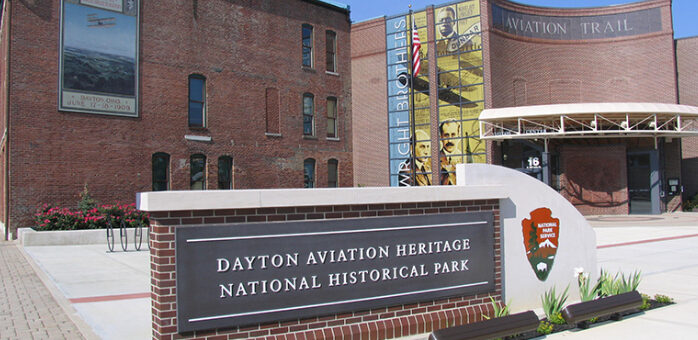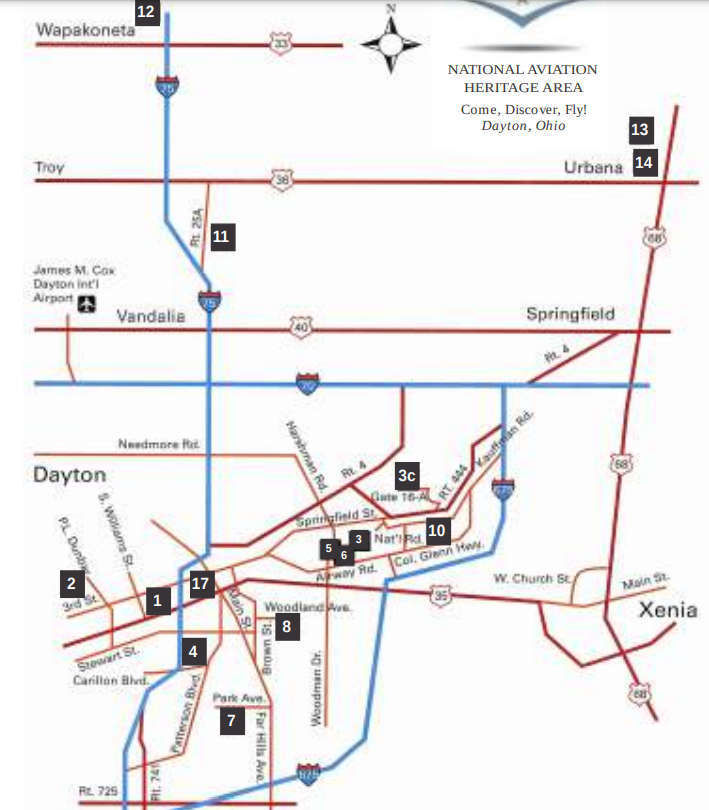
Explore the Aviation Trail in Dayton, Ohio
Are you interested in aviation history and the beginning of flight? If you are, you might want to explore the self-guided Aviation Trail tour in Dayton, Ohio. The tour includes 17 historic aviation sites where you can learn about the beginning of flight and how flight has changed and expanded over the last century to include space travel. You could even receive a Willbear for participating in the Aviation Trail. Let’s take a look at some of the free aviation experiences available on the tour.
Get a Free Wilbear
Wilbur and Orville Wright created the first powered flying machine. In honor of their accomplishment and to congratulate guests who visit a minimum of 8 of the sites, Aviation Trail, Inc. hands out free stuffed Wilbear Wrights. Only one site is required, and that is the Wright-Dunbar Interpretive Center and Visitors Center, which is located at 16 South Williams Street. You may want to visit the center first on your tour because you’ll be provided with valuable information and a required stamp. However, you can also visit the Wright-Dunbar Interpretive Center later in your tour and instead start your tour at Carillon Historic Park or the National Museum of the United States Air Force.
If you want to visit the Wright-Dunbar Interpretive Center later in your tour, you can choose another place to visit first, like the Huffman Prairie Flying Field, Carillon Historical Park, or the National Museum of the U.S. Air Force. Any of those four sites can help you get started on the aviation tour and explain how you can get your free Willbear.
Aviation Trail Historic Sites
In order to get your free Wilbear, you only have to visit 8 of the 17 aviation sites on the aviation trail. In this article, we’ll review the sites that don’t charge an entrance fee.
Site 1: Wright-Dunbar Interpretive Center and Aviation Trail Visitors Center, Aviation Trail Parachute Museum, and the Wright Cycle Company
Site 1 includes sites 1a, 1b, and 1c, and they are all located at 16 South Williams Street.
1a – Wright-Dunbar Interpretive Center and Aviation Trail Visitors Center
This section of Site 1 is located in the Hoover Block Building. The center got its name from the friendship between the Wright Brothers and Paul Lawrence Dunbar. From 1890 to 1895, Orville and Wilber ran a printing business on the second floor of the building. One of their best clients was a Black poet named Paul Lawrence Dunbar. Visitors can view the location of the old print shop and learn about the relationship between Dunbar and the Wright brothers.
1b – Aviation Trail Parachute Museum
Visitors can find the Aviation Trail Parachute Museum on the second floor, along with the old print shop. The museum tells the detailed story of the history of free=fall parachutes. For instance, did you know that free-fall parachutes were invented at McCook Field, which was located in Dayton, Ohio? The field was used for the research, development, and advancement of aviation technology, and one of those advancements was the invention of the free-fall parachute by Guy Ball and Floyd Smith. The first test jump of their design was performed by Mr. Leslie Irvin in 1919 at McCook Field. At the Aviation Trail Parachute Museum, you’ll learn about this and more.
1c – The Wright Cycle Company
The Wright Cycle Company building is in its original location. This is where Wilber and Orville built and repaired bicycles while inventing the airplane. The profits from the bicycle shop were used to fund the building of their airplanes.
Site 2: The Paul Dunbar House Historic Site
Paul Lawrence Dunbar lived his final years at the house on 219 North Lawrence Dunbar Street, which is now part of the Dayton Aviation Heritage Historical Park. Paul Lawrence Dunbar lived from June 27, 1872, until February 9, 1906. During his lifetime, he wrote 12 poetry books, four short story books, and four novels. He was best known for his amazing use of dialect. Not to mention, he was quite skilled at using rhetoric and metaphors. Dunbar is famous for his works, the fact that he was the first African American to earn enough from his writing to support himself, and the preservation of the Paul Dunbar House honors his legacy.
Site 3: The Wright Brothers Memorial, Huffman Prairie Flying Field, and the Huffman Prairie Flying Field Interpretive Center.
The third stop on the tour encompasses three sites, which are located at 2380 Memorial Road at Wright-Patterson Air Force Base.
3a – The Wright Brothers Memorial
The Wright Brothers Memorial is aptly placed on the hill overlooking Huffman Prairie Flying Field, which is known as the Wright Brothers Hill. The flying field that it overlooks was used by Orville and Wilbur to test their early flying machines. Later, the brothers operated their flight school out of the field.
3b – Huffman Prairie Flying Field Interpretive Center
At the interpretive center, guests can learn about Orville and Wilbur’s early airplanes, test flights, and flight school. The Huffman Prairie Flying Field Interpretive Center also teaches guests about the history of Wright-Patterson Air Force Base, which encompasses 8,145 acres. In fact, did you know that the base got its start with the Huffman Prairie Flying Field? You’ll learn all about the history of the air force base at the interpretive center.
3c – Huffman Prairie Flying Field
The Wright brothers trained 119 pilots at Huffman Prairie Flying Field from 1910 through 1916. They charged each student pilot $250, which would be about $8,359 today. It was a two-week course that included ground school and four hours of flight time. This was considered enough instruction to become an expert in flying. Of those 119 students, several went on to become military pilots, including Frank P. Lahm, Frederic E. Humphries, and Henry “Hap” Arnold, who went on to become a five-star general.
Site 5: National Museum of the U.S. Air Force
The National Museum of the U.S. Air Force is located at 1100 Spaatz Street. It holds the record for being the largest military aviation museum in the world. This year is the museum’s 102nd anniversary. The museum boasts more than 350 aerospace vehicles and thousands of artifacts in its 20 acres of indoor space.
Site 6: National Aviation Hall of Fame
The National Aviation Hall of Fame resides next door to the National Museum of the U.S. Air Force. The National Aviation Hall of Fame honors aviation pioneers and innovators like Buzz Aldrin, Clarence E. Bud Anderson, Neil Armstrong, Olive Beech, and William Edward Boeing.
Site 8: Woodland Cemetery and Arboretum
The Wright family, including Orville, Wilber, Katherine, Milton, and Susan, are all buried in the family plot at the Woodland Cemetery and Arboretum. It’s also worth noting that Paul Lawrence Dunbar is also buried near the Wrights.
Site 9: The Wright “B” Flyer at the Dayton Wright Brothers Museum
The Wright “B” Flyer was the first mass-produced airplane. This amazing marvel of engineering was produced at the Wright Company factory that was located in Dayton. The Wright “B” Flyer at Site 8 is located inside a specially built hangar that resembles the one the Wright Brothers used in 1910. However, it’s not an original Wright Flyer. Instead, this replica was built by a team of early aviation enthusiasts.
Site 10: Wright State University Archives
If you’re interested in perusing the writings of Orville and Wilbur, you’ll want to take a trip over to the Wright State University Archives. The university was named after the Wright Brothers and houses the largest number of Wright Brothers manuscripts. In addition to the letters, the archive also has 4,000 photographs and 400 collections related to aviation history.
Site 13: Champaign Aviation Museum in Urbana
Number 13 on the Aviation Trail is the Champaign Aviation Museum. It’s located at Grimes Field and houses several historic aircraft, including a B-17G, a B-17, and a B-25N.
Site 14: The Grimes Flying Lab
The Grimes Flying Lab is also located in Urbana, OH. This exhibit is a modified C-45H that was used for testing aircraft lighting systems for night flight.
Site 16: Butler County Warbirds Inc.
Butler County Warbirds Inc. is located in Middletown, OH at the Middletown Regional Airport. Visitors can view the warbirds on display and learn about their history. Rides in the warbirds are also available.
Site 17: The Sinclair National UAS Training and Certification Center
The Sinclair National UAS Training and Certification Center is located on the Sinclair College campus in Building 13. Participants of the Aviation Trail tour can learn about the college, its aviation research, and various programs at the first-floor lobby kiosk. That’s also where you get your Wilbear stamp.
The Aviation Trail in Dayton, Ohio, is the perfect aviation getaway for pilots, enthusiasts, aviation history buffs, and their families. In addition to the mentioned site, you could also visit Carillon Historic Park, Hawthorne Hill, the Historic WACO Field and Airplane Museum, the Armstrong Air & Space Museum, and the Tri-State Warbird Museum. However, it’s important to note that those sites have entrance fees. It’s important to note that you must get a stamp from at least eight sites in order to qualify for a Wilbear. If you’d like to get your Wilbear in person, one can be picked up at the Wright-Dunbar Interpretive Center.
